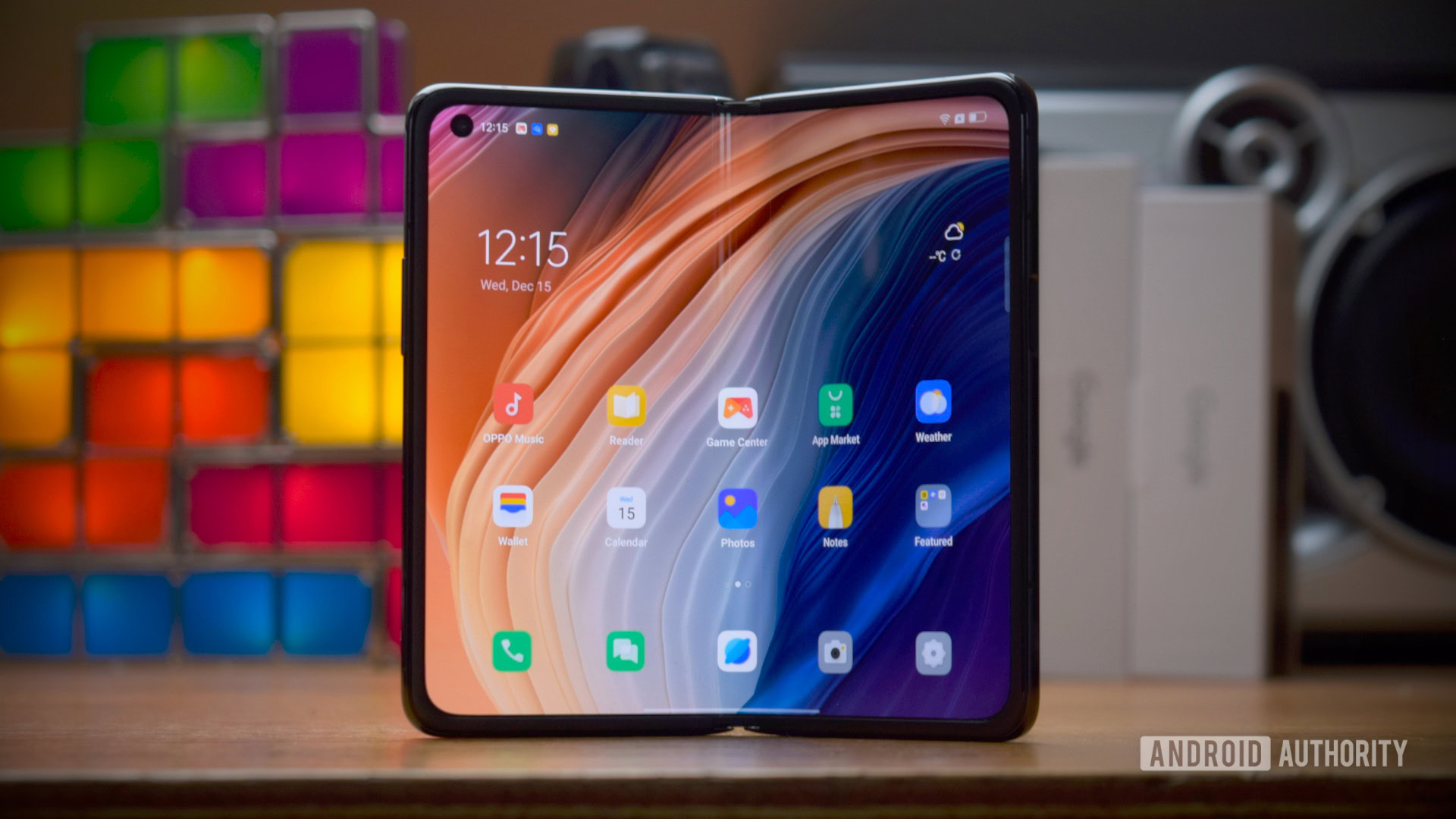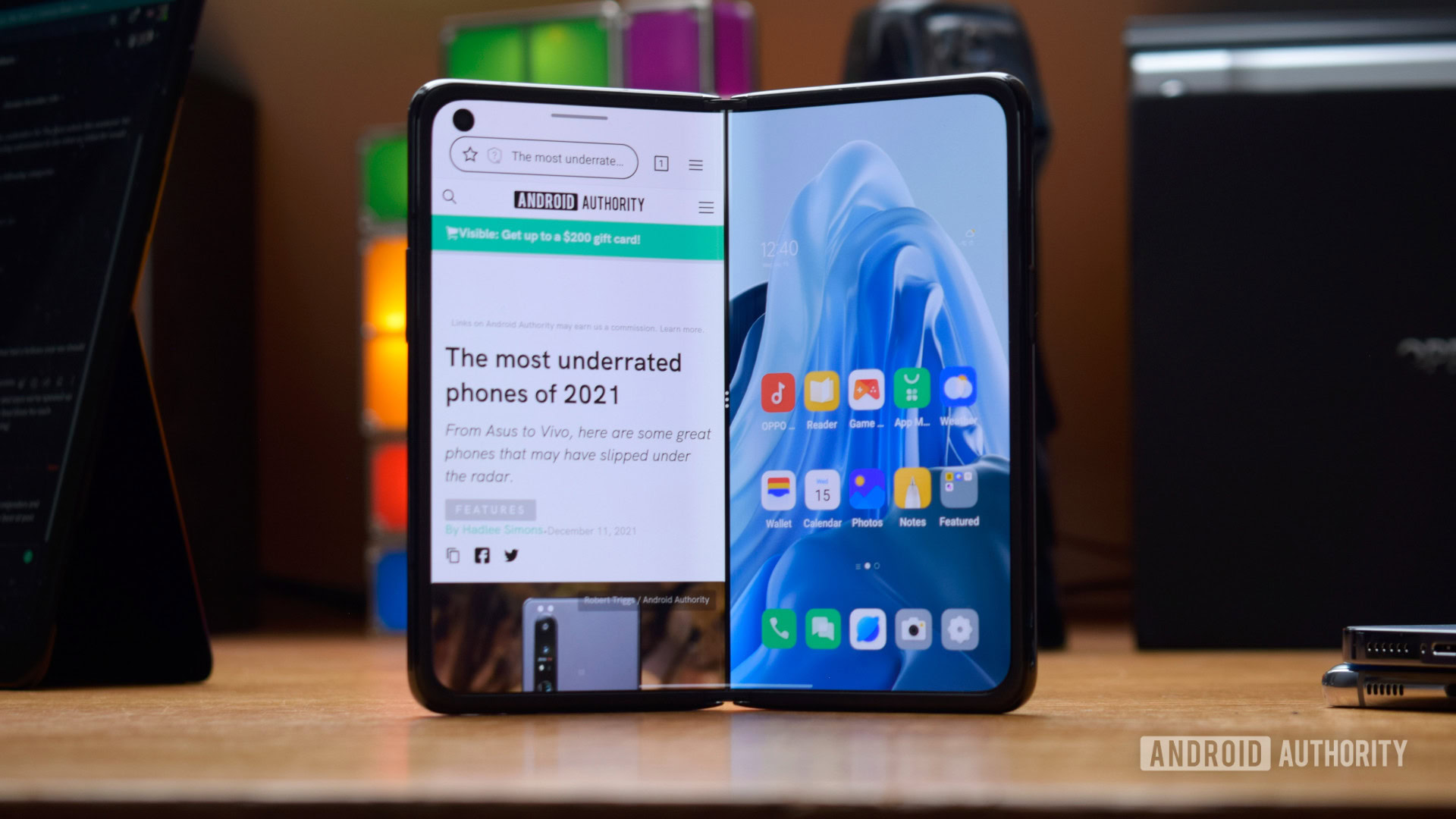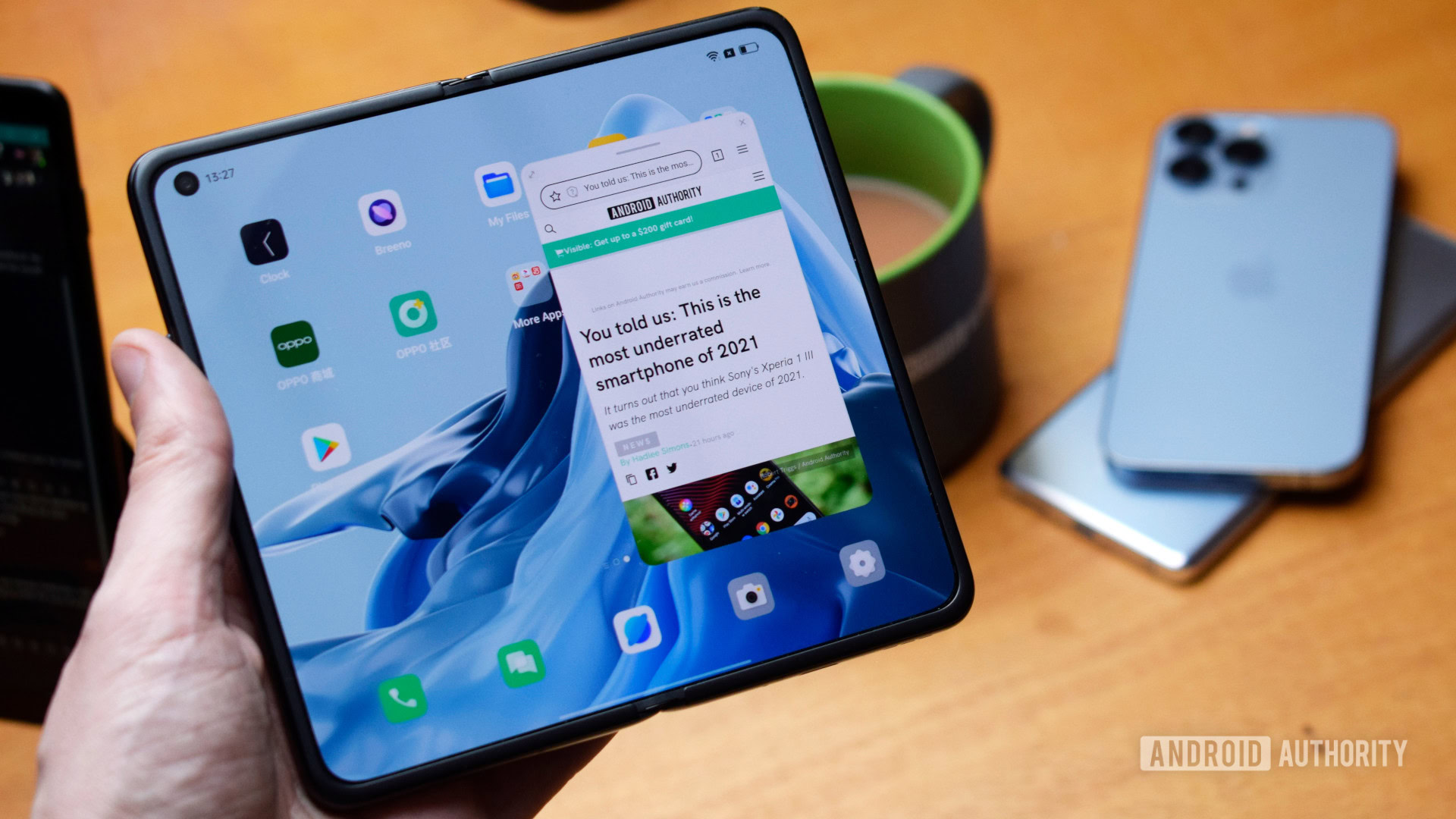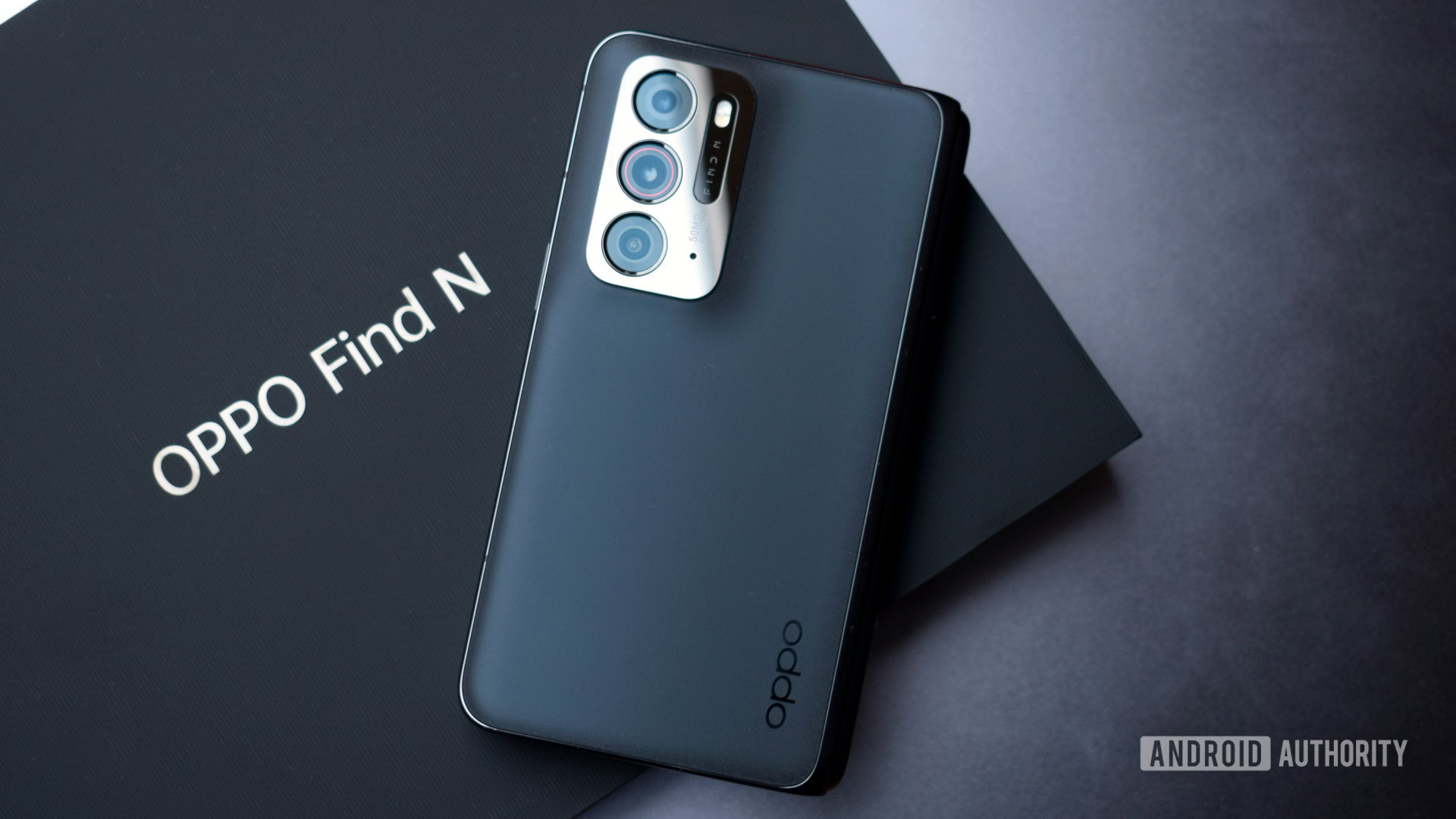Affiliate links on Android Authority may earn us a commission. Learn more.
This is the OPPO Find N: Another one joins the fold
Published onDecember 15, 2021

After years of development and teasers, OPPO has just launched its first commercial foldable smartphone — the OPPO Find N. Unlike rival foldable products, OPPO has opted for a much more compact sub-6-inch closed size, but has it finally nailed the perfect flexible form factor?
You should check out our announcement article for all the specifications and other ins and outs. Here, I want to talk about my first impressions of OPPO’s new foldable after spending a few hours with it. As a side note, this is also my first hands-on experience with any foldable smartphone. I’d like to think of myself as unjaded by the teething pains of early prototypes and I have high hopes that this phone feels like a finished product. Let’s jump right in.
OPPO Find N: From prototype to prime time
OPPO has worked on six generations of foldable smartphones over the past four years but this is the first to make it past the prototype state. The company states that it didn’t feel these products were quite ready for mass-market as the timing and tech weren’t quite right. Well, that extra time has clearly been well spent — the Find N is immaculately designed and feels every bit a phone built for daily use.
There’s a metal frame running around both the display and the camera housing, accompanied by a plush soft anti-fingerprint back. It’s incredibly stylish for a smartphone, let alone a foldable. This definitely isn’t a prototype, at least aesthetically. My only gripe about the design is the inner bezels are a little thick and cheaper-looking than the outside of the phone.
The OPPO Find N is incredibly stylish for a smartphone, let alone a foldable.
Importantly, for a foldable, the hinge feels robust. OPPO sent its hinge for assessment with TÜV which says it’s built to last at least 200,000 folds. That’s enough to open and close the display more than 100 times a day, every day for the next five years. There’s a wide metal spine that’s the correct width to avoid adding a gap between the displays when closed. Everything is nice and flush with no obvious gaps for dirt and dust to find their way in on the display side. Although there is a small gap between the spine and panels to allow for movement. Unlike the Galaxy Z Fold 3, however, there’s no official water resistance on offer, though OPPO has suggested it’ll survive splashes of water.
The front and back panels of the phone wrap around this center spine with a satisfying snap when fully open. There’s a slight spring-loaded action when the display is almost fully open, which is a bit of a nuisance if you don’t want the phone quite fully open. Although the display will hold its position firmly between 50-120 degrees. I don’t recommend using the phone in a folded fashion though, as the display takes on a notable tint that impacts visibility.
See also: How much does it cost to replace a foldable phone’s screen?
Now about that display. The 7.1-inch 120Hz LPTO inner panel looks fantastic. There’s plenty of screen real estate for running two apps side by side or when using the floating window. Upon closing, you can see that the display crinkles slightly in two places rather than one due to the hinge design. While there’s no obvious crease right now, it’ll be interesting to observe how this design holds up over many weeks and months of continuous use.
The 5.48-inch 60Hz outer display is definitely not as swanky as the inner panel but it’s perfectly serviceable and far more traditional than, say, the Galaxy Z Fold 3’s awkwardly tall and thin front-facing display.
The Find N feels every bit as good in the hand as any of the premium smartphones I've used this year.
I actually wasn’t convinced about the phone’s small size at first. Having become accustomed to 6.5-inch panels, it’s not a display I’d personally want to spend much time browsing the web on. But that’s what the inner panel is for. The OPPO Find N’s compact front display is perfect for checking email and sending messages, exactly the sort of thing you’ll need the phone to do when you quickly pull it out of your pocket.
Overall, I’m impressed with the built quality and design of the OPPO Find N. It’s every bit as good in the hand as the many, many other premium smartphones I’ve used this year.
Software for a new form factor

I’m still experimenting with the Find N’s software but I’m not quite convinced OPPO has nailed this part of the formula quite as well. It doesn’t help that some features and apps haven’t been translated from Chinese, although this is the launch market so we’ll overlook that for now.
The OPPO Find N runs a standard version of Color OS 11 (based on Android 11) with a few foldable-specific tweaks. The most useful is Dual Window, which splits the display in half to use two apps side by side with a simple dual-finger swipe down the middle of the screen. This works very well and although there’s a slight delay when entering this mode performance feels solid. App support is mostly very good, although a few of OPPO’s own apps, such as the camera and phone app, don’t work with this feature. You also can’t position the windows on top of one another when turning the display, which would be a nice feature for watching video and doing something else at once.

Floating Window is another handy way to multitask if you still want to use the larger display to its full potential. You can quickly pinch an app down to a smaller size using four or five fingers. Sadly, once again, not every app works in this mode which limits its usefulness and makes me less inclined to experiment with it. You also can’t enter Dual Window when there’s a floating window present, which is somewhat annoying, and you can only store one app to use as a floating window at once. So it’s not as powerful a setup as Samsung’s Edge Panel.
One particularly neat feature is the option to show a camera preview on the front display, allowing your friends and family to get themselves in the frame and pose as they wish. A few of OPPO’s apps, such as contacts and messages, also leverage the larger screen size by positioning options side by side to make better use of the space. Sadly features like notifications aren’t organized in the same way. As such, the overall experience still feels like a traditional smartphone with big-screen features bolted on, rather than a completely seamless experience.
The form factor feels like it would really benefit from Android12L.
We asked OPPO about the possibility of Android 12L coming to the Find N but, since the software isn’t commercially available yet, OPPO isn’t sure if it will support Google’s big-screen OS implementation. This is unfortunate, as the phone would definitely benefit from some of the more seamless large-screen features heading our way with L. What we do know is that the phone will receive an update to Android 12 in the not too distant future.
OPPO Find N: First impressions

I’ve only spent a short while with the OPPO Find N but can definitely see the phone’s potential. OPPO seems to have solved most of the hardware issues that we’ve come to associate with early foldables, such as display creases and dubious hinges. However, after my albeit short first outing with a foldable, I’m still not convinced the form factor offers a big enough departure from traditional smartphones to justify the steep investment and lingering issues just yet. At least not until software comes along to streamline the app experience.
OPPO has convinced me about foldable hardware but I'm still not 100% on the software experience.
Of course, there’s the matter of availability too. The phone is launching exclusively in China and although OPPO has its eye on a potential European release it has given no firm commitments or timeframe for if or when this might happen. And at 7,699 yuan (~$1,210) up to 8,999 yuan (~$1,414), I’m still not sold on the value proposition of the Find N. Especially now that Samsung’s Galaxy Z Flip 3 costs $999, putting foldables firmly into mainstream flagship territory.
What do you think, is the OPPO Find N hot or not?